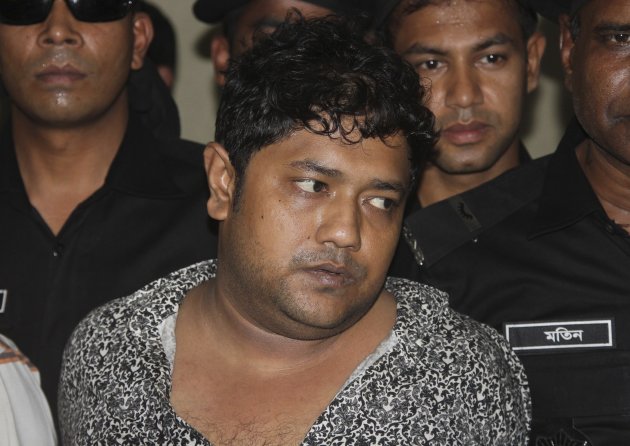
SAVAR, Bangladesh
(AP) -- The fugitive owner of an illegally constructed building that
collapsed and killed at least 377 people was captured by commandos as he
tried to flee into India. At the disaster site, meanwhile, fire broke
out in the rubble and forced authorities to suspend the search for
survivors temporarily.
Mohammed Sohel Rana was arrested Sunday in the western border town of Benapole, said Jahangir Kabir Nanak,
junior minister for local government. Rana was brought back by
helicopter to the capital of Dhaka where he faced charges of negligence.
Many of those killed worked at clothing factories in the building, known as the Rana Plaza,
and the collapse was the deadliest disaster to hit the garment industry
in Bangladesh that is worth $20 billion annually, supplies global
retailers and is a mainstay of the economy.
The blaze was caused by sparks as rescuers tried to cut through a steel rod to reach the woman, said a volunteer, Syed Al-Amin Roman. At least three rescuers were injured in the fire, he said. It forced them to retreat while firefighters frantically hosed down the flames.
Officials believe the fire is
likely to have killed the trapped woman, said army spokesman Shahinul
Islam. Rescue workers had delayed the use of heavy equipment
for several hours in the hope that she could be extricated from the
rubble first. But with the woman presumed dead, they began using heavy
equipment around midnight.
Wearing a printed shirt, Rana was sweating as two security officers held him by his arms. A security official helped him to drink water after he gestured he was thirsty. He did not speak during the 10-minute appearance, and he is likely to be handed over to police, who will have to charge him and produce him in court within 24 hours.
A small-time political operative from the ruling Awami League party, Rana had been on the run since the building collapsed Wednesday. He last appeared in public Tuesday in front of the Rana Plaza after huge cracks appeared in the building.
Witnesses said Rana assured tenants, including five garment factories,
that the building was safe. Police, however, ordered an evacuation. A
bank and some first-floor shops closed, but managers of the garment
factories on the upper floors told workers to continue their shifts.
Rana's arrest was ordered by Prime Minister Sheikh Hasina, who is also the Awami League leader.
On Saturday, police arrested three owners of two factories. Also detained were Rana's wife and two government engineers who were involved in giving approval for the building design. Local TV stations reported that the Bangladesh High Court has frozen the bank accounts of the owners of all five garment factories in the Rana Plaza.
A garment manufacturers' group said the factories in the building employed 3,122 workers, but it was not clear how many were inside when it fell. About 2,500 survivors have been accounted for.
Army Maj. Gen. Chowdhury Hasan Suhrawardy,
the coordinator of the rescue operations, said the next phase of the
search involved the heavy equipment such as hydraulic cranes that were
brought to the disaster site Sunday. Searchers had been manually
shifting concrete blocks with the help of light equipment such as
pickaxes and shovels, he said.
In a rare bit of good news, a female worker was pulled out alive Sunday. Rescuer Hasan Akbari said when he tried to extricate a man next to the woman, "he said his body was being torn apart. So I had to let go. But God willing, we will be able to rescue him with more help very soon."
The collapse and previous disasters in garment factories have focused attention on the poor working conditions of workers who toil for as little as $38 a month to produce clothing for top international brands.
The death toll surpassed a fire five months ago that killed 112 people and brought widespread pledges to improve worker-safety standards. But since then, very little has changed in Bangladesh.
Its garment industry was the third-largest in the world in 2011, after China and Italy, having grown rapidly in the past decade.
Among the garment makers in the building were Phantom Apparels, Phantom Tac, Ether Tex, New Wave Style and New Wave Bottoms. Altogether, they produced several million shirts, pants and other garments a year.
The New Wave companies, according to their website, make clothing for several major North American and European retailers.
Britain's Primark acknowledged it was using a factory in Rana Plaza, but many other retailers distanced themselves from the disaster, saying they were not involved with the factories at the time of the collapse or had not recently ordered garments from them.
Wal-Mart said none of its clothing had been authorized to be made in the facility, but it is investigating whether there was any unauthorized production.
No comments:
Post a Comment